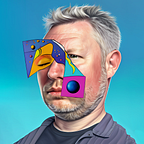Your own private internet
From images and copy, to colours and layout, the bots will shape-shift the web for your attention.
The other day, I was talking with a technical project manager about artificial intelligence when I had a flash of the future: dynamic website experiences that are created by AI — on-the-fly — uniquely for you…
From images and copy, to colours and layout, the bots will shape-shift the web for your attention.
A thought experiment
Later this year, a 20-year-old white female college student from Toronto visits a landing page for a major bank.
The images she sees on the page look like her peers. The copy is a touch ironic, uses slang she’s familiar with, and includes a few jokes. The selling points speak directly to her current challenges.
The visual design of the page is complex, with overlapping images and trendy illustrations, all drawn from the brightest colours in the existing brand palette in an effort to appear exciting, fresh and forward-looking.
At the very same moment, a 65-year-old retired woman of colour from Vancouver visits the exact same URL, but gets a different experience.
The images that are created (on the fly, for her) look like her peers. The generated copy is empathetic (and there are no jokes). The selling points are relevant to her, and delivered in a warm, supportive tone.
The colours lean toward the muted end of the brand palette, conveying stability and trust. The fonts are larger, to appeal to aging eyes, while the layouts are quiet, orderly and reassuring.
Except in this scenario, no human being ever designed these pages.
Instead, based on their different browsing habits, cookie trails, and other known information, these pages are generated whole cloth by AI to appeal to them in different ways.
And with each new visitor, the AI system learns which combinations of messaging, imagery and layout create longer engagement times for each demographic; which button placements get the most clicks; and which calls to action inspire the most sign-ups.
One website to rule them all
Ad agencies can mimic this kind of thing today, of course, by manually creating different landing pages for different marketing demographics, and testing and iterating on them relentlessly. They can also create different advertising campaigns to reach different audiences, too.
But under the current model, each target audience your client wants to reach increases the time and effort required to reach them.
So what if the bank’s landing page system could learn — on its own — how to speak effectively to just about anyone?
It could also create (and test) its own ads, luring users to a dynamic landing page that it creates in an instant, depending on who’s looking.
If this sounds far-fetched, know that way back in 2016, Netflix was already generating and testing their own ads using AI.
They even customize your homepage interface, right down to the thumbnails you see, based on your unique viewing habits.
And if you think bot-driven interfaces are a long way off, companies like UIzard are promising AI-driven interface design with a click — and there’s nearly 1,000 AI-driven Figma plug-ins already, with more arriving daily.
We’re only a hop, skip and a jump toward automating the whole process of front-end web design and coding.
And once that happens, marketers would be foolish not to customize various aspects of UI and UX to appeal to different demographics — or even individual users. (I can honestly see some real upsides here regarding accessibility.)
Of course, privacy legislation — in the EU especially — provides some roadblocks here. Then again, maybe consumers can be lured to opt-in, in exchange for the promise of increasingly more “relevant” content.
Advertisers have been salivating for this level of personalization ever since movies like Minority Report promised a future of ads they could only dream of in the early 2000s.
So there may be a day coming soon where you and I — lumped by the bots into different demographics — won’t even experience the same web page at the same URL.
Instead, the world of AI-driven marketing will cater to each of us, echoing back what it thinks will resonate best, creating a fun house mirror version of reality where everything is overly familiar.
(I’m not advocating for this future, by the way, so much as seeing its potential inevitability. It actually sounds a bit dystopian to me: talk about creating echo chambers! Everywhere I go it’s all me, me, me. People who look like me, who dress like me, walk, talk and act like me…)
The end of web design?
Then again, maybe this dynamic website future won’t come to pass at all. In fact, websites, as we know them, may be about to vanish.
Spend a few minutes asking chatGPT your questions, and suddenly, combing through a page of Google search results by yourself feels antiquated. And worse, inconvenient.
And when you can do it all via voice, chatting with the bot in your earbud, monitors might start to feel like microfiche.
It remains to be seen whether web pages will survive in a new era of personal AI assistants. The bots will still have to gather their information from somewhere, but it might be from a “web” of that’s data invisible to us humans.
Until then, expect to see marketing agencies — and the software companies that support them — jumping onto the bandwagon of AI-driven experience design.
And if you’re a designer, your role in that world may become less about setting a definitive design, and more about setting the initial guardrails that keep the AI on-brand and on-message.
(Want to join me and a community of designers who are defining the future of AI-driven design together? Check out UnicornSnacks.ai)
